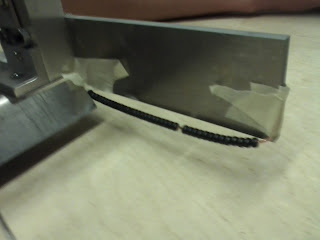In summary, the final function of our robot was to trap balls on the table using the shown arms with crossbar, and to drive them to the goal while being guided by the bead rails and bent-over plate. The two metal motors provided plenty of torque to complete the driving during this task and allowed for easy turning. The 6-speed motor driving the arm bar also had sufficient torque to make the movement controllable in competition. The following is a description of the final problems we encountered, as well as techniques and decisions we used to complete our machine for competition.
The main problem that we faced in manufacturing our robot was coupling our motors to the shafts that they needed to power. For the six speed motor, the one powering the arm that captures balls and that pushes the tower, we used plastic tubing connected to a brass coupling from a motor kit, secured with pins. This proved to be an effective method, although the tubing added a slight lag when controlling the arm.
For the metal motors, we manufactured a small aluminum coupling that connected the motor to the gear that drives the shaft. It took two attempts to make such a precise piece, but we were able to manufacture an effective coupling. The gear was fit onto the smaller end of our aluminum coupling and secured with a pin. The other end of the coupling, which was attached to the motor itself, was secured with a set screw. While very concerning at first, our homemade couplings proved to be sufficient.
There were also several additional components that we added to our design after testing it on the playing table. First, when driving into balls, we found that the rubber ones in particular would catch on the underside of the front edge of the machine. To remedy this issue we added an aluminum cover to the front edge of the machine. This prevented the edges of the machine from digging into the rubber of the balls and allowed us to smoothly capture balls of any kind.
We also found however, that the rubber balls were catching on the underside of the containment side rails. This posed a more difficult problem because it is not possible to immediately remedy this situation. It unfortunately came to a decision where we had to choose where we wanted to lose points. We created rails of beads that would allow us to collect the balls without a problem, but the only way that we could attach them as an afterthought like this would be with glue (shown below, temporarily attached with tape), which is not a great design and manufacturing technique. We therefore had to choose between losing points for not being able to easily collect all the balls, or losing points for poor design. Our decision was made last minute to include the bead rails after talking with the GSIs.
We also encountered difficulty when driving because of how front loaded our machine is. We were initially not even able to drive over the hinges on the table. To fix this problem we manufactured a heavy name plate that was attached to the rear of the machine to weigh it down, which fixed the problem and also added to the visual appeal of our design.
Unfortunately, during testing, we also found that we could not push the tower. We had to gear up our metal motors in order to provide the necessary torque to push the tower, but the cheap plastic gears that were provided for our use simply cannot support such power. When we try to push it they just begin to grind down and destroy themselves. Given metal gears, pushing the tower would be feasible with our design, but for the competition, it does not appear that we will be incorporating a tower push in our strategy. Luckily our design is versatile, and we will most likely play to score first and play defense from there on out.






No comments:
Post a Comment